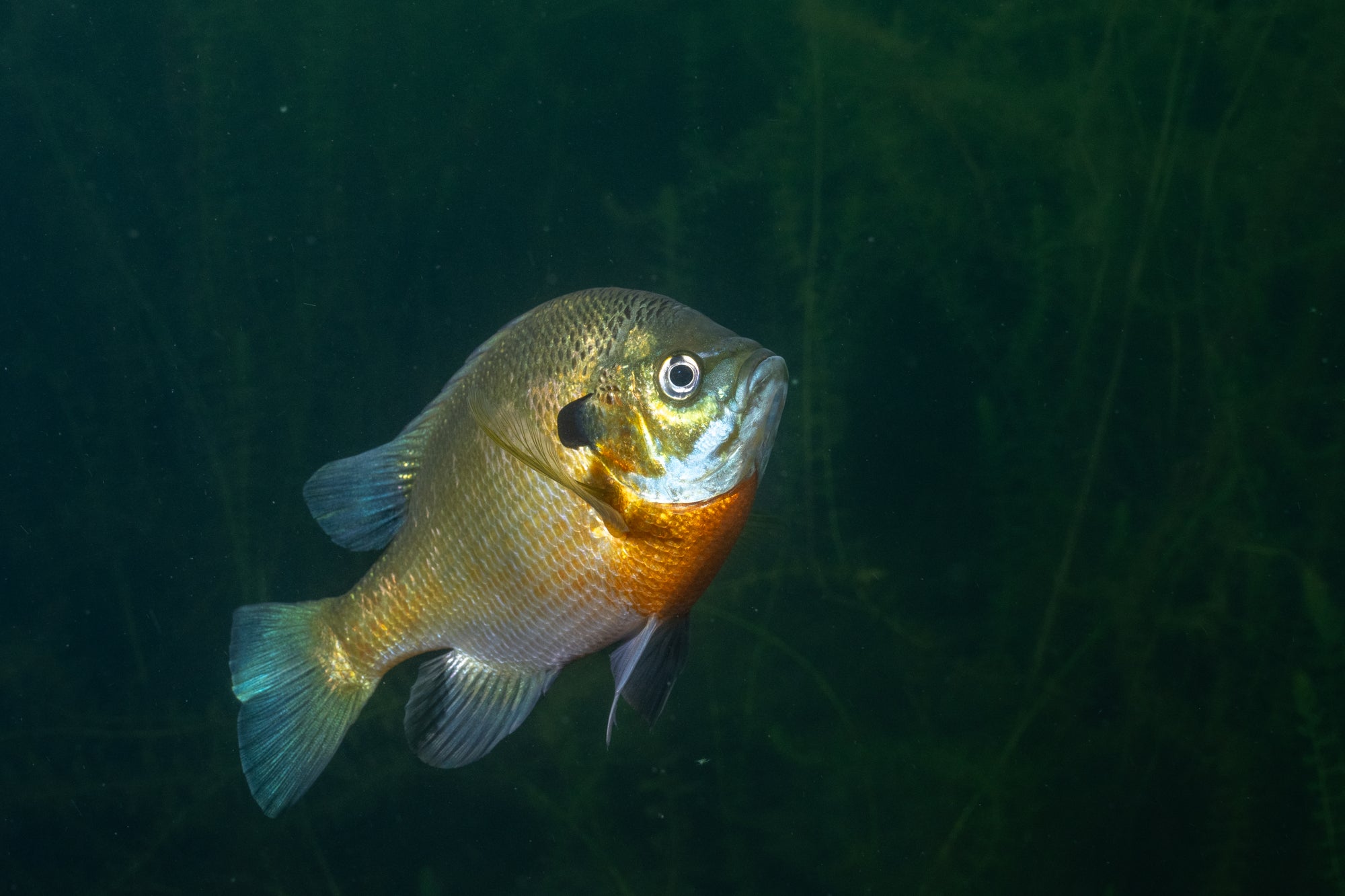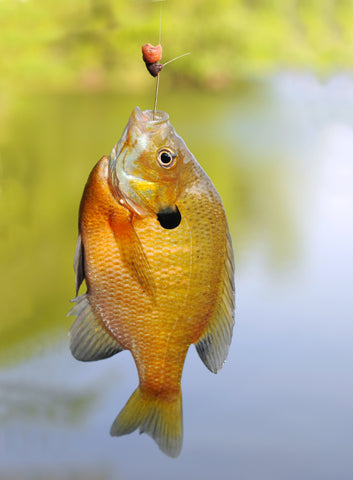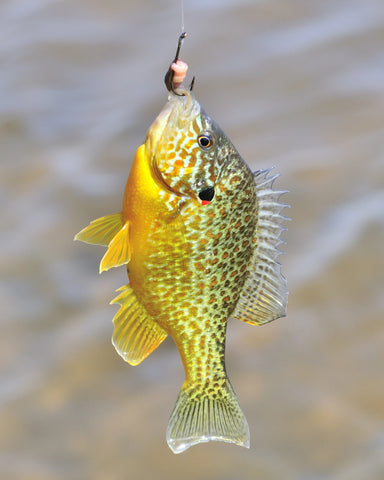Bluegill vs. Bream
Bluegill vs. Bream: The Great Debate
(Fishing Identification Series)

Welcome to My Bait Shop's Bluegill vs. Bream (Which is correct? The great debate.) Part of our new Fishing Tips section and Fish Identification Series. In this article we will cover Bluegill vs. Bream vs. Sunfish, Perch and a few other names you may or may not have heard of. Maybe we will even get to which is correct...
Growing up in Wisconsin I loved fishing for Bluegill, Sunfish, Perch, Crappie and all kinds of panfish. Little did I know there was confusion about the actual names of these fish. It wasn't until I got older and traveled around the country that I found regional differences in what some people call these fish.
In the angling world, the terms "bluegill" and "bream" often surface in discussions, sometimes interchangeably, which can lead to confusion. Both belong to the sunfish family, a group known for its vibrant colors and diverse species. This article delves into the distinctions and similarities between bluegill and bream, exploring their habitats, behaviors, and the role they play in the ecosystem and fishing community.
Webster's defines Bluegill as a common sunfish (Lepomis macrochirus) of the eastern and central U.S. sought for food and sport
While bluegill is the correct name, this fish reginionally goes by many other names. These include but may not be limited to bream, brim, sunfish, sunny, perch, copper nose, and crappie.
Bluegill: A Closer Look
Bluegill (Lepomis macrochirus) is a species of freshwater fish native to North America, renowned for its distinctive blue and purple face and darkly spotted dorsal fin. They are commonly found in lakes, rivers, and ponds across the continent, thriving in waters with abundant vegetation that provides both food and protection from predators. Bluegills have a varied diet that includes insects, larvae, and small invertebrates.
One of the bluegill's most notable features is its breeding behavior. Males create and guard nests in colonies, and their vibrant breeding colors make them a spectacle during spawning season. Bluegills are prolific breeders, which contributes to their abundance in North American waters.
In terms of fishing, bluegills are a popular target for both novice and experienced anglers due to their willingness to bite on a wide variety of baits and lures. Their aggressive nature, especially during the spawn, makes them an exciting catch despite their smaller size, which typically ranges from 4 to 12 inches in length.


Bream: Broadening the Scope
"Bream" is a term that can cause some confusion, as it is used differently in various parts of the world. In the United States, "bream" is often used as a blanket term to describe several species within the sunfish family, including bluegills, pumpkinseed, and redear sunfish. These species share similar habitats and behaviors, contributing to the generalization of the term.
Regionally "bream", "bull" or "roach" is sometimes used to refer to a male bluegill during spawning season when he is darkened or colored up for spawning. When they are in pre-spawn through spawn and post-spawn, the male bluegill will obtain this color while the female will remain pale. Outside of the spawning period they look pretty much the same.
In Europe, however, "bream" refers to a completely different set of species, primarily the common bream (Abramis brama), which belongs to the cyprinid family. European bream are known for their laterally compressed bodies and preference for slow-moving or still waters, contrasting with the American usage of the term to describe the more laterally rounded sunfish species.
Despite these regional differences in terminology, when discussing bream in the context of American waters, one is often referring to a variety of sunfish species that are popular among anglers for their sportive qualities and culinary value.
Habitat and Behavior: Bluegill vs. Bream (Sunfish)
Both bluegills and the broader category of bream (as understood in the U.S.) share similar habitats—freshwater bodies with ample vegetation. This commonality in habitat preference underscores the sunfish family's adaptability and resilience, making them a prevalent sight in North American waters.
Their diets are also similar, consisting largely of insects, crustaceans, and other small invertebrates. This diet contributes to their role in the ecosystem as a key species in controlling insect populations and serving as prey for larger predators, including bass and pike.
Fishing and Culinary Value
Bluegills and other bream species are celebrated for their fight and flavor. Anglers appreciate these fish for their aggressive response to both live and artificial baits, making them an enjoyable catch for fishing enthusiasts of all skill levels. The challenge of catching a bream, combined with their widespread availability, makes them a favorite target across the U.S.
Fishing for bluegill is an excellent way to introduce children and new fishermen and women to fishing because the fish will bite on a variety of baits. You can catch bluegill on a bobber and worm, grubs, crickets, grasshoppers, a cane pole or fly fish with flies or poppers.
Bluegill can be caught throughout the year, but the best time may be during the spawn when the big males are protecting their nests. Casting over their circular shaped nests is guaranteed to elicit an aggressive strike.
Ice fishing for bluegills can also be quite rewarding and is a great way to introduce new anglers to the sport. Bluegills generally will be active throughout the winter off of deeper drop offs and weed beds. Jigging with a small grub on a tear shape jig and bobber usually does the trick. They also usually provide enough action to keep young anglers from getting bored.
Culinarily, bluegills and other bream species are highly regarded for their light, flaky flesh. They are often pan-fried or grilled providing a delightful meal for anglers and their families. Their size makes them easy to prepare, and their abundance ensures that they are a sustainable choice for anglers looking to enjoy a fresh catch.
Conservation and Sustainability
While bluegills and bream are abundant in many areas, their popularity demands responsible fishing practices to ensure their populations remain healthy. This includes respecting size and bag limits, practicing catch and release when appropriate, and maintaining habitat health. Conservation efforts are crucial in areas where water quality and habitat degradation pose threats to sunfish populations.
Conclusion
In conclusion, while the terms "bluegill" and "bream" may sometimes be used interchangeably, they can refer to specific species or a broader category of sunfish, depending on the context. Both bluegills and the wider group of bream within the sunfish family are cherished components of the North American freshwater ecosystem, offering angling excitement and culinary enjoyment. Understanding the nuances between these terms and the species they describe enriches the angling experience and fosters a deeper appreciation for these vibrant freshwater inhabitants. To answer the question we started with Bluegill vs. Bream, technically it is a Bluegill. However given the joy they provide anglers around the country, call them whatever you want.
25 Vintage Fishing Lures Worth A Fortune
20 Vintage Heddon Fishing Lures Worth A Fortune
20 Vintage Creek Fishing Lures Worth A Fortune
Fish Weight Calculator: Our very own Fish Weight Calculator at My Bait Shop.
Bait & Tackle 101: Another article from our Fishing 101 Series in our Fishing Tips Library.
Musky Fishing 101: Another article from our Fishing 101 Series in our Fishing Tips Library.
Fishing Tips Index: The Index to all of our Fishing Tips articles.

